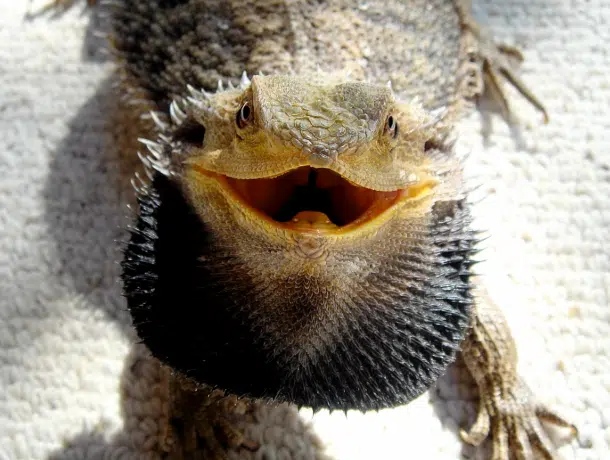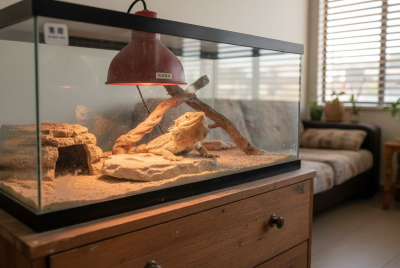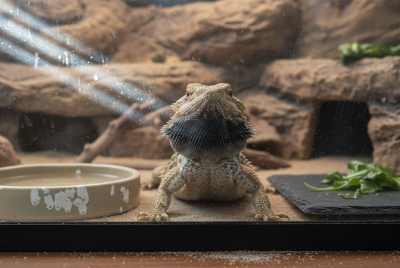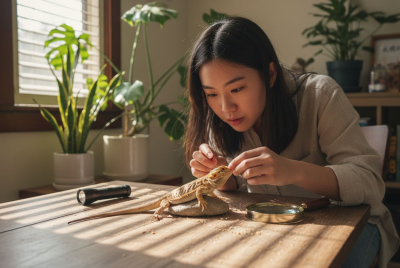Why Is My Bearded Dragon Beard Black?
Bearded dragon owners often ask, “Why is my bearded dragon’s beard turning black?” It’s a common concern, and if you’re anything like me, you want to make sure your scaly friend is happy and healthy. The black beard can be alarming at first glance, but don’t worry. I’m here to walk you through the most common reasons your bearded dragon’s beard turns black and how to handle it.
Understanding the Black Beard
First off, let’s get one thing straight—bearded dragons puffing up and turning their beard black is pretty normal behavior, but it’s important to understand the context. Whether it’s stress, a sign of dominance, or something else, understanding why your dragon does this will help you take better care of them.
Normal Beard Behavior in Bearded Dragons
Before jumping into all the possible reasons for your dragon’s darkened beard, it’s crucial to know that a black beard is not always a sign of something wrong.
What Is a Black Beard in Bearded Dragons?
A “black beard” refers to the darkening of the skin under the dragon’s throat. When a bearded dragon puffs it up and it turns black, it’s usually a way for them to express something, just like how we might use facial expressions.
When Does It Happen Naturally?
Dragons tend to display a black beard when they’re showing off, feel threatened, or want to establish dominance. If your dragon is healthy and they only do this occasionally, it’s likely part of their natural behavior.
Stress and Anxiety: A Common Cause of a Black Beard
One of the most common reasons your dragon might be darkening its beard is stress. Like people, bearded dragons have their limits, and changes in their environment can make them anxious.
Environmental Factors Leading to Stress
Many things in your dragon’s setup can cause stress, so it’s essential to create the best environment possible for them.
Temperature Fluctuations
Temperature is a huge deal for reptiles. If your dragon’s tank is too hot or too cold, it could trigger stress. Make sure you have the right temperature gradient in the tank—basking spots should be around 95-110°F, while the cooler side should be around 75-85°F.
Improper Lighting
Lighting goes hand-in-hand with temperature. Bearded dragons need UVB light to synthesize vitamin D3, which helps with calcium absorption. Without proper lighting, they can get stressed and may even develop health issues. I always recommend investing in a quality UVB bulb.
Handling and Social Stressors
Handling your bearded dragon too often or incorrectly can also cause anxiety. They may not always enjoy being held, especially by strangers. If you notice your dragon’s beard turning black when you’re handling them, it might be a sign to back off a bit.
Aggression and Dominance Display
Another common reason for a black beard is when your dragon is feeling dominant or aggressive.
Territorial Behavior in Males
Males are particularly prone to showing off their black beards when they’re trying to establish dominance over their territory. If you have more than one dragon, this can happen often.
Breeding Season Changes
During the breeding season, both male and female bearded dragons may darken their beards. Males do it to impress females, and females may display it as part of the mating process. If this happens around mating season, it’s perfectly normal behavior.
Health Issues That May Cause a Black Beard
Now, on to the more serious reasons. Sometimes a black beard can be a sign of underlying health issues.
Respiratory Infections
One of the most concerning reasons for a black beard is illness, such as a respiratory infection. If your dragon is wheezing, has mucus around the nose or mouth, and is lethargic, you should consult a vet immediately.
Parasites
Parasites like mites can also cause your dragon stress, which may lead to a black beard. If you notice any unusual behavior combined with a loss of appetite or diarrhea, get them checked for parasites.
Dehydration
Dehydration is a less obvious cause of a black beard but still important. Be sure your dragon has plenty of water available, and offer them water via misting or soaking them in a shallow dish every so often.
Fear and New Environments
A black beard can also mean your dragon is scared. Moving them to a new tank or introducing a new pet can make them nervous.
Introducing a New Pet
If you’ve recently introduced a new pet, like another bearded dragon or even a dog, your bearded dragon might react by turning their beard black. Give them time to adjust, and try to keep their environment calm.
Moving to a New Habitat
Did you move their tank recently or change the setup? Bearded dragons love routine, and even the slightest change can stress them out. If that’s the case, try to maintain consistency in their environment.
How to Help Your Bearded Dragon
So, what should you do if your dragon’s beard is turning black? There are a few things you can try.
Create a Comfortable Environment
Make sure your dragon has a habitat that makes them feel safe. This includes correct lighting, temperature, and plenty of hiding spots.
Handle with Care
If your dragon is turning black when handled, give them some space. Try not to overhandle them, especially if they seem stressed.
Monitor Health Regularly
Lastly, always keep an eye on their health. If you notice other symptoms alongside the black beard—like loss of appetite, lethargy, or breathing problems—visit a vet as soon as possible.
Conclusion
In most cases, a black beard is nothing to worry about. Bearded dragons have unique ways of communicating, and a black beard is often just one of their quirky behaviors. However, it’s always a good idea to be aware of their environment and health to ensure your dragon stays happy and stress-free.




